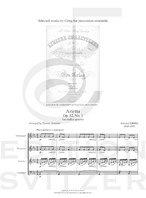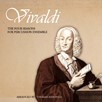
Selected works by Grieg for percussion ensemble
Composer: Edvard Grieg
Instrument: Percussion Ensemble
Level: unknown
Published: 2013
Price: €40.00
Item details
-
Description +
-
Arranged by Thomas Aanonlie
Duration: 30 min.In my second published work for Editon Svitzer I have arranged six pieces from Edvard Grieg’s piano collection Lyric Pieces:
1. Arietta, Op. 12, No. 1 (quartet) glockenspiel, vibraphone, 2 marimbas.2. Little Bird, Op. 43, No. 4 (quartet) glockenspiel, xylophone, 2 marimbas.
3. March of the Dwarfs, Op. 54, No. 3 (trio) in which one musician plays both xylophone and glockenspiel, a second musician plays both marimba 1 and vibraphone and the third plays marimba 2.
4. Brooklet, Op. 62, No. 4 (quartet) glockenspiel, vibraphone, 2 marimbas.
5. Wedding Day at Troldhaugen, Op. 65 No. 6 – (sextet) glockenspiel, xylophone, 2 marimbas, vibraphone and timpani.
6. Puck, Op. 71, No. 3 (quintet) glockenspiel, vibraphone, 2 marimbas, timpani.
-
-
Instrumentation +
-
Percussion Ensemble:
1. Arietta, Op. 12, No. 1 (quartet) glockenspiel, vibraphone, 2 marimbas.2. Little Bird, Op. 43, No. 4 (quartet) glockenspiel, xylophone, 2 marimbas.
3. March of the Dwarfs, Op. 54, No. 3 (trio) in which one musician plays both xylophone and glockenspiel, a second musician plays both marimba 1 and vibraphone and the third plays marimba 2.
4. Brooklet, Op. 62, No. 4 (quartet) glockenspiel, vibraphone, 2 marimbas.
5. Wedding Day at Troldhaugen, Op. 65 No. 6 – (sextet) glockenspiel, xylophone, 2 marimbas, vibraphone and timpani.
6. Puck, Op. 71, No. 3 (quintet) glockenspiel, vibraphone, 2 marimbas, timpani.
-
-
About the composer +
-
Edvard Hagerup Grieg (15 June 1843 – 4 September 1907) was a Norwegian composer and pianist. He is widely considered one of the leading Romantic era composers, and his music is part of the standard classical repertoire worldwide. His use and development of Norwegian folk music in his own compositions put the music of Norway in the international spectrum, as well as helping to develop a national identity, much as Jean Sibelius and Antonín Dvořák did in Finland and Bohemia, respectively. Grieg is regarded as simultaneously nationalistic and cosmopolitan in his orientation, for although born in Bergen and buried there, he traveled widely throughout Europe, and considered his music to express both the beauty of Norwegian rural life and the culture of Europe as a whole. He is the most celebrated person from the city of Bergen, with numerous statues depicting his image, and many cultural entities named after him: the city's largest building (Grieg Hall), its most advanced music school (Grieg Academy), its professional choir (Edvard Grieg Kor), and even some private companies that include its largest hotel (Quality Hotel Edvard Grieg), and a music technology developer (Grieg Music). The Edvard Grieg Museum in Troldhaugen (Grieg's former home in Bergen) is dedicated to his legacy.
-
-
Reviews +
-
Percussive Notes, November 2016
Thomas Aanonlie has given us another collection of arrangements that work well with a variety of ensembles. This particular collection tends towards the more difficult side at times, whether due to technical or musical considerations.
There are a number of different scorings in this collection, from the “Arietta Op. 12, No. 1” and “Brokklet, Op. 62, No. 4,” both scored for glockenspiel, vibraphone, and two marimbas, to more involved ensembles such as the “March of the Dwarfs, Op. 54, No. 3” and “Puck, Op. 71, No. 3,” which both involve a number of mallet instruments and timpani. The arranger notes that accommodations can be made and are welcomed if certain instruments, such as a 5-octave marimba or a 20-inch timpani are not available. This type of flexibility is applauded, given how many programs do not have these instruments.
Musically, the movements provide much variety, from the flowing “Arietta” to the brisk “Puck.” Each movement also presents its own set of challenges, from the connecting of separated lines in “March of the Dwarfs” to the hocket nature of some passages in “Wedding- day at Troldhaugen.” Some of these challenges might have been avoided if these arrangements were made with a little more consideration to the idiom for which they were being arranged. For example, the previously mentioned hocket passages between two marimbas could easily have been combined and redistributed to make the passages more approachable by less experienced performers.
The variety in musical material as well as instrumentation possibilities make the collection accessible to a number of different percussion programs, though the difficulty of some of the movements may be the deciding factor. Overall this collection provides a number of pieces that would work well on a high school or university percussion ensemble concert.
—Brian Nozny
-
-
Credits +
-
Front Cover graphics and layout: Alfred Kubin
Translation: Maria Susanne Svenfelt
Engraving: Johan Svitzer
Printed in Copenhagen, Denmark
Copyright © Edition SVITZER
www.editionsvitzer.com
-




